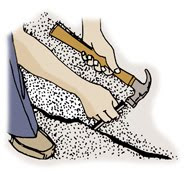Soldier pile and lagging walls are some of the oldest forms of retaining systems used in deep excavations. These walls have successfully being used since the late 18th century in metropolitan cities like New York, Berlin, and London. The method is also commonly known as the "Berlin Wall" when steel piles and timber lagging is used. Alternatively, caissons, circular pipes, or concrete piles can also be used as soldier piles but at an increased cost. Timber lagging is typically used although reinforced concrete panels can be also utilized for permanent conditions. Soldier pile walls are formed by:
1. Constructing soldier piles at regular intervals (6 ft to 12 ft, typical)
2. Excavating in small stages and installing lagging.
3. Backfilling and compacting the void space behind the lagging.
Moment resistance in soldier pile and lagging walls is provided solely by the soldier piles. Passive soil resistance is obtained by embedding the soldier piles beneath the excavation grade. The lagging bridges and retains soil across piles and transfers the lateral load to the soldier pile system.
Shallow excavations can be supported using cantilevered steel soldier beams with timber lagging boards installed between them as the excavation progresses. Soldier beams can be driven with conventional pile driving equipment or installed vibration free as shown.
Soldier beams and timber lagging in many cases will be the most economical choice for support of excavation.
Deeper excavations will require internally braced soldier beams to prevent excessive movements of the sheeting system and corresponding settlement of the soils behind the sheeting. Diagonal (raker) braces carry loads from the soldier beams to heel blocks below final excavation levels.
Tieback anchors can replace internal braces to provide an excavation free of obstructions. Tiebacks are constructed by drilling a small diameter shaft into the ground behind the sheeting system. Steel tendons are inserted into the shaft. Grout is pumped into the shaft to anchor the tendons as the drill casing is retracted. Hydraulic jacks lock off the tieback to the sheeting system. Multiple levels of tiebacks allow for deeper excavations.










No comments:
Post a Comment